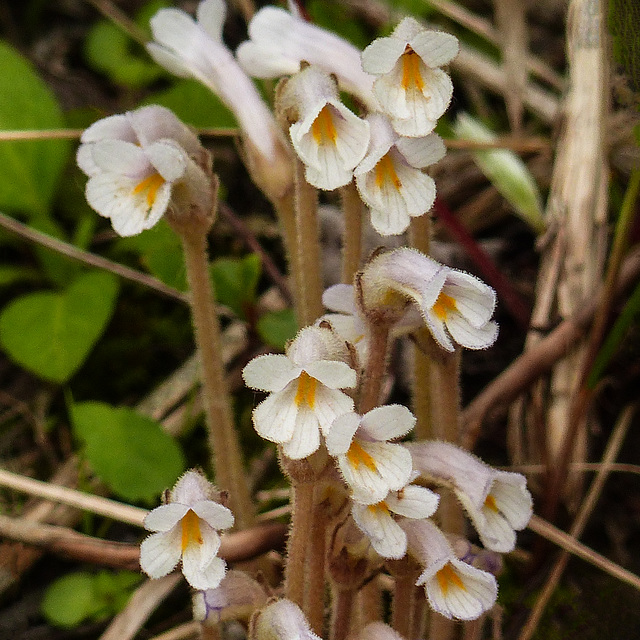Clustered Broomrape / Orobanche fasciculata
Delicate Pinedrops / Pterospora andromedea
Pinedrops / Pterospora - rare, Listed S2
Pinedrops / Pterospora - rare
Pinedrops
Pinedrops
The beauty of Pinedrops
Pinedrops / Pterospora
Orobanche / Orobanche fasciculata
Parasitic One-flowered Broomrape / Orobanche unifl…
Tiny Spotted Coralroot flower
Clustered Broomrape, Orobanche fasciculata
One-flowered Broomrape
See also...
Keywords
Authorizations, license
-
Visible by: Everyone -
All rights reserved
-
400 visits
Clustered Broomrape / Orobanche fasciculata


I believe I have the correct ID for this Orobanche plant - Clustered Broomrape. Not the most photogenic cluster, but I love seeing this plant on very rare occasions.
"Orobanche (broomrape or broom-rape) is a genus of over 200 species of parasitic herbaceous plants in the family Orobanchaceae, mostly native to the temperate Northern Hemisphere. Some species formerly included in this genus are now referred to the genus Conopholis. The broomrape plant is small, from 10–60 cm tall depending on species. It is best recognized by its yellow- to straw-coloured stems completely lacking chlorophyll, bearing yellow, white, or blue snapdragon-like flowers. The flower shoots are scaly, with a dense terminal spike of between ten and twenty flowers in most species, although single in O. uniflora. The leaves are merely triangular scales. The seeds are minute, tan-to-brown, and blacken with age. These plants generally flower from late winter to late spring. When they are not flowering, no part of the plants is visible above the surface of the soil.
As they have no chlorophyll, they are totally dependent on other plants for nutrients. Broomrape seeds remain dormant in the soil, often for many years, until stimulated to germinate by certain compounds produced by living plant roots. Broomrape seedlings put out a root-like growth, which attaches to the roots of nearby hosts. Once attached to a host, the broomrape robs its host of water and nutrients.
Some species are only able to parasitise a single plant species, such as ivy broomrape Orobanche hederae, which is restricted to parasitising ivy; these species are often named after the plant they parasitise. Others can infect several genera, such as the lesser broomrape O. minor, which lives on clover and other related Fabaceae." From Wikiedia.
en.wikipedia.org/wiki/Orobanche
This macro photo of Broomrape / Orobanche was taken on 23 June 2015, on a botany walk at Griffith Woods, off Highway 8 in Calgary.
"Orobanche (broomrape or broom-rape) is a genus of over 200 species of parasitic herbaceous plants in the family Orobanchaceae, mostly native to the temperate Northern Hemisphere. Some species formerly included in this genus are now referred to the genus Conopholis. The broomrape plant is small, from 10–60 cm tall depending on species. It is best recognized by its yellow- to straw-coloured stems completely lacking chlorophyll, bearing yellow, white, or blue snapdragon-like flowers. The flower shoots are scaly, with a dense terminal spike of between ten and twenty flowers in most species, although single in O. uniflora. The leaves are merely triangular scales. The seeds are minute, tan-to-brown, and blacken with age. These plants generally flower from late winter to late spring. When they are not flowering, no part of the plants is visible above the surface of the soil.
As they have no chlorophyll, they are totally dependent on other plants for nutrients. Broomrape seeds remain dormant in the soil, often for many years, until stimulated to germinate by certain compounds produced by living plant roots. Broomrape seedlings put out a root-like growth, which attaches to the roots of nearby hosts. Once attached to a host, the broomrape robs its host of water and nutrients.
Some species are only able to parasitise a single plant species, such as ivy broomrape Orobanche hederae, which is restricted to parasitising ivy; these species are often named after the plant they parasitise. Others can infect several genera, such as the lesser broomrape O. minor, which lives on clover and other related Fabaceae." From Wikiedia.
en.wikipedia.org/wiki/Orobanche
This macro photo of Broomrape / Orobanche was taken on 23 June 2015, on a botany walk at Griffith Woods, off Highway 8 in Calgary.
- Keyboard shortcuts:
Jump to top
RSS feed- Latest comments - Subscribe to the comment feeds of this photo
- ipernity © 2007-2024
- Help & Contact
|
Club news
|
About ipernity
|
History |
ipernity Club & Prices |
Guide of good conduct
Donate | Group guidelines | Privacy policy | Terms of use | Statutes | In memoria -
Facebook
Twitter

Sign-in to write a comment.